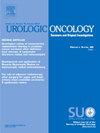Prognostic and predictive value of tertiary lymphoid structures in TURBT materials: Should it be seated in the routine pathological examination, and can it be used in deciding on the treatment method?
IF 2.4
3区 医学
Q3 ONCOLOGY
Urologic Oncology-seminars and Original Investigations
Pub Date : 2024-08-01
DOI:10.1016/j.urolonc.2024.06.010
引用次数: 0
Abstract
Objective
This study aims to reveal the importance of tertiary lymphoid structures (TLS) in transurethral resection of bladder tumor (TURBT) materials with a practical and applicable method in which the effect of a certain threshold value on survival and treatment response can be implicated.
Methods
TURBT materials that had not previously received any treatment (chemotherapy, radiotherapy, or immunotherapy) and were diagnosed for the first time at Mardin Training and Research Hospital between 2014 and 2022 were included in the study. The maximum TLS per 4× magnification field (field diameter: 4.5 mm) was recorded. Grouping and statistical analysis of the TLS number were performed using threshold values of “≥1”, “≥2”, and “≥3”.
Results
TLSs were more frequently found in high-grade tumors (P = 0.008) and showed a strong association with stage progression (P < 0.001). It was also significantly associated with many adverse histopathological parameters. Conversely, high TLS (≥1, ≥2, and ≥3) appeared to be associated with fewer recurrences (P = 0.032, P = 0.001, and P = 0.018, respectively), and cases with higher TLS showed longer recurrence-free survival (P = 0.089, P = 0.023, P = 0.037, respectively). TLS≥3 was found to be an independent parameter that was associated with favorable RFS (P = 0.019, HR = 0.401), and multifocality was found to be an independent risk factor for RFS (P = 0.023, HR = 2.302).
Conclusion
This study is the first to demonstrate the relationship between the presence and specific thresholds of TLS in TURBT materials with prognostic parameters. Including this information in the routine pathological examination of TURBT materials will allow a more accurate approach to treatment and follow-up, especially in patients with non-muscle invasive bladder cancer (NMIBC).
TURBT 材料中三级淋巴结构的预后和预测价值:是否应将其纳入常规病理检查,是否可用于决定治疗方法?
研究目的本研究旨在通过一种实用且适用的方法揭示经尿道膀胱肿瘤切除术(TURBT)材料中三级淋巴结构(TLS)的重要性,并通过该方法揭示一定阈值对生存率和治疗反应的影响:研究对象包括 2014 年至 2022 年期间在马尔丁培训与研究医院首次确诊、之前未接受过任何治疗(化疗、放疗或免疫疗法)的 TURBT 患者。记录每个 4 倍放大视野(视野直径:4.5 毫米)的最大 TLS。使用"≥1"、"≥2 "和"≥3 "的阈值对 TLS 数量进行分组和统计分析:TLS多见于高级别肿瘤(P = 0.008),并与分期进展密切相关(P < 0.001)。它还与许多不利的组织病理学参数密切相关。相反,高TLS(≥1、≥2和≥3)似乎与较少复发有关(分别为P = 0.032、P = 0.001和P = 0.018),TLS较高的病例无复发生存期较长(分别为P = 0.089、P = 0.023和P = 0.037)。研究发现,TLS≥3是与良好RFS相关的独立参数(P = 0.019,HR = 0.401),多灶性是RFS的独立危险因素(P = 0.023,HR = 2.302):本研究首次证明了TURBT材料中TLS的存在和特异性阈值与预后参数之间的关系。将这一信息纳入TURBT材料的常规病理检查,将使治疗和随访方法更加准确,尤其是非肌层浸润性膀胱癌(NMIBC)患者。
本文章由计算机程序翻译,如有差异,请以英文原文为准。
求助全文
约1分钟内获得全文
求助全文
来源期刊
CiteScore
4.80
自引率
3.70%
发文量
297
审稿时长
7.6 weeks
期刊介绍:
Urologic Oncology: Seminars and Original Investigations is the official journal of the Society of Urologic Oncology. The journal publishes practical, timely, and relevant clinical and basic science research articles which address any aspect of urologic oncology. Each issue comprises original research, news and topics, survey articles providing short commentaries on other important articles in the urologic oncology literature, and reviews including an in-depth Seminar examining a specific clinical dilemma. The journal periodically publishes supplement issues devoted to areas of current interest to the urologic oncology community. Articles published are of interest to researchers and the clinicians involved in the practice of urologic oncology including urologists, oncologists, and radiologists.

 求助内容:
求助内容: 应助结果提醒方式:
应助结果提醒方式:


